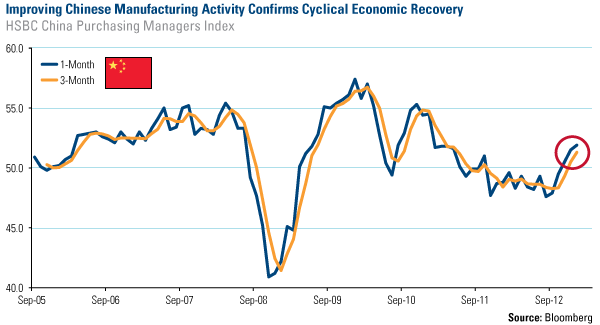Emerging Markets Radar (January 28, 2013)
Strengths
• Flash HSBC China PMI was 51.9 in January, better than the expected 51.7 and improved from December’s reading of 51.4. All sub-indices improved again, except new orders were down 20 basis points from December, at 52.7 versus 52.9. A PMI above 50 indicates industrial activities are expanding.
• According to People’s Bank of China (PBOC), total outstanding real estate related loans were RMB12.1 trillion at the end of 2012, up 13 percent year-over-year. Loans to developers outstanding were RMB3.9 trillion, up 11 percent year-over-year. Personal mortgage loans outstanding were RMB 8.2 trillion, up 14 percent year-over-year.
• Chinese solar names were strong last week due to government subsidies and increased solar power targets for the year. More supportive policies are said to be in the pipeline.
• Hong Kong exports went up 14.4 percent in December, versus the estimate of 9.4 percent.
• Countries such as Peru, Colombia and Mexico, where demographics skew younger, and the middle class is expanding, have proven a very good opportunity for credit growth. “The population in Latin America is very young and is entering a credit accumulation stage,” said Wendy Hannam, executive vice-president of Latin America for Scotiabank.
Weaknesses
• Recent headline news in China had filled with government officials selling luxury properties across the country even at a huge discount. Those sales were said to be motivated to either hide their wealth or to avoid having to report publicly as China’s new leadership has determined to clean up corruption.
• The Philippines’ imports were lackluster in November by rising only 2.2 percent, indicating slower production for domestic demand.
• CLSA coal analysts lowered the coal price for 2013 due to improved rail transportation capacity in China, driving down the coal price. This is negative for coal stocks in Indonesia and China.
• Korea’s fourth-quarter GDP growth was 1.5 percent, below consensus forecast of 1.8 percent. Weak export markets and a depreciating Japanese Yen are threats to Korean businesses and GDP growth.
• Thailand’s December exports were up 13.45 percent out of the low base the same month last year, but the market was expecting 21.5 percent.
• Singapore’s December industrial production was down 0.6 percent compared to being up 2.9 percent in November, but contracted at a slower pace than the market consensus of -4.8 percent.
• Industrial production in Russia surprised on the downside, slowing down to 1.4 percent year-over-year in December from 1.9 percent year-over-year in November.
• The cost of high crime and violence in Latin America is staggering. In Brazil alone, people pay an extra $13 billion to gain a sense of security, while in Uruguay economic activity suffers a negative impact of more than 3.0 percent of gross domestic product. This is according to a series of studies commissioned by the Inter-American Development Bank (IDB) in an attempt to quantify the cost of crime and violence in Latin America and the Caribbean.
Opportunities

• The chart above shows HSBC China Manufacturing PMI is reaching a two-year high above 50 expansionary levels. The improving PMI confirms China’s economic growth recovery in the fourth quarter last year, and points to growth momentum into this year.
• Strengthening of domestic demand in Mexico and Turkey may keep supporting GDP growth and even temper lower external demand.
• Favorable developments in Iraqi Kurdistan -- lack of Baghdad reprisal after the entry of oil majors into KRG, the oil and gas export agreement with Turkey, and progressing infrastructure projects -- bode well for the exploration companies operating in the region.
• John Kerry, who has been nominated for U.S. Secretary of State, said at his senate confirmation hearing on Thursday that he hoped Washington could make progress in the Western Hemisphere with improved relations with Venezuela, Bolivia and Ecuador, much like the success the United States had with Colombia. He stated, "Colombia is a model for the region. It is an example to the rest of Latin America about what awaits them if we can convince people to make better decisions."
Threats
• The number of H-share companies in share placement increased last week causing selling pressures among peers. After H-share stocks rallied 27.5 percent since early September last year, share placements are clearly a short-term price risk.
• “Squeezing the Last Drops” is the title of the 159-page outlook report by the Deutsche Bank’s emerging markets fixed-income research team. Bond yields have compressed, and it is not a question of whether, but rather when the “Great Rotation” from fixed income into equities will begin.
• Uncertainty regarding electricity supply in Brazil may have a negative consequence on investment decisions and makes the growth forecast for 2013 vulnerable to disappointment.
• The current rally in Latin American currencies has exporters in the region calling for fiscal and monetary policy action. Exporters fear the appreciation will erase their competitive edge at a time of slowing demand for exports by Europe and the U.S. In Peru, Colombia and Chile, the dollars are flowing in as investors seek the higher returns emerging markets offer.













